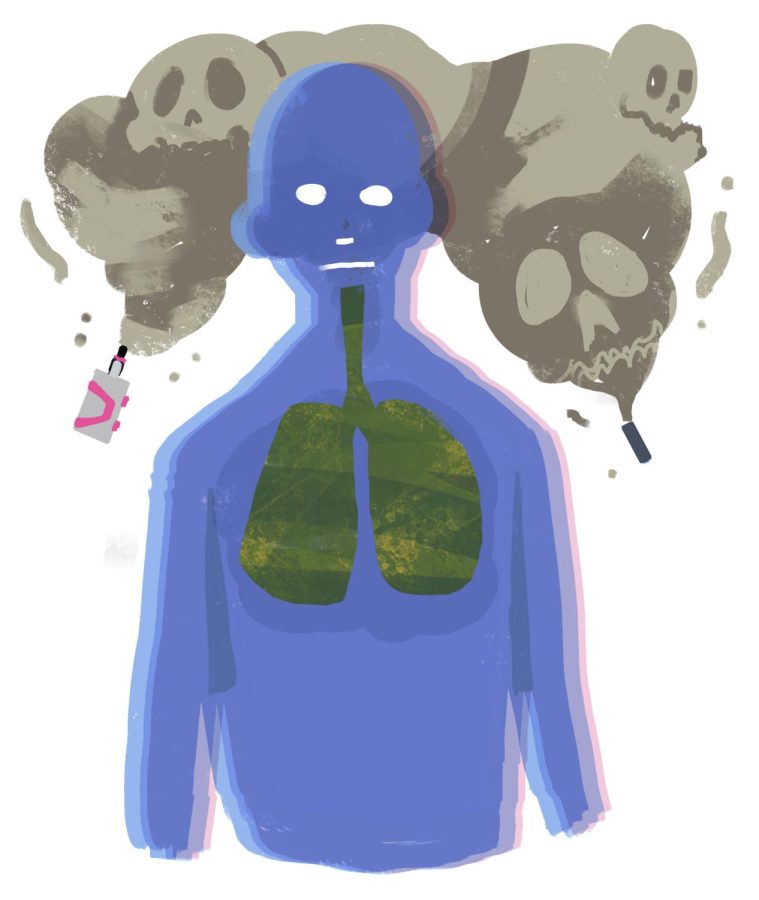Vapers beware: Are vaping, lung disease linked?
August 28, 2019
Researchers at Summit County Public Health (SCPH) found a history of vaping among teenagers and young adults recently treated for severe pulmonary disease. A press release from SCPH said since August 21, 2019, 153 possible cases have been reported across 16 states, including six in Ohio. Some reported cases included products containing tetrahydrocannabinol (THC).
Reported symptoms include cough, chest pain, dizziness, fatigue, headache, vomiting, diarrhea and worsening difficulty breathing. Symptoms worsen over a period of days or weeks before admission to the hospital.
SCPH Policy and Legislative Affairs Manager Cory Kendrick said they aren’t certain the reported cases are linked directly to vaping, but said the six cases in Ohio are being investigated.
“It’s well known that the chemicals and ingredients in these vaping products cause inflammation of the lungs,” Kendrick said.
Kendrick said by senior year, almost half of high school students in Summit County reported trying a vape product at least once.
A report from the Surgeon General found 5 percent of middle schoolers used e-cigarettes in 2018. Among high school students, that number is more than 20 percent. In Summit County, one in four high school students have used a vape product in the last 30 days.
“Well, the e-cigarette and vaping industry has done a very good job of fooling us into that it’s a safe alternative to smoking when, in fact, it’s really not. You’re trading one addiction for another. We don’t know the long-term consequences of the chemicals they’re using,” Kendrick said.
“We know that in addition to the high levels of nicotine delivery, these products have multiple cancer-causing chemicals,” Kendrick said. “There are heavy metals, such as nickel, tin and lead. And the chemical flavorings, which are the most carcinogenic, are also linked to serious lung diseases. So there are just multiple risk factors with these.”
The Ohio Department of Health is asking health care providers treating patients with suspected serious pulmonary illness of unclear origin who have a history of using vaping products to report these suspected cases to their local health department, according to a press release from the Summit County Public Health Department.
Vape products may contain high levels of nicotine, carcinogenic chemicals, heavy metals, such as nickel, tin and lead, and chemical flavorings linked to lung disease. Kendrick said flavored e-liquid contains chemicals that become carcinogenic when superheated. The Surgeon General report found 68 percent of e-cigarette users in high school use flavored e-liquid.
Brooke Bender, an employee at Puff n’ Stuff in Kent, has seen some changes in sales between its mod models and regular e-juice sales. She said business typically picks up as students return to campus.
“With the kids coming back, we have turned a lot away because they’re not 21 yet,” Bender said. “We haven’t had problems with fake IDs, but we more so have a problem with people trying to buy for other people.”
In October 2019, Ohio will become the 18th state to raise the minimum age for buying cigarettes from 18 to 21. Governor Mike DeWine also vetoed the grandfather clause, which would have exempted people who are between 18 and 20 by the time the law is enacted. DeWine vetoed the provision because he said this age range is when most daily smokers take up the habit.
Kendrick said many students obtain nicotine products from older students. “We know from previous surveys that 37 percent of kids who get vaping products are able to just get them at the store while 25 percent get them from older students,” Kendrick said.
In a statement, Juul Labs Inc. CEO Kevin Burns said he supports DeWine’s decision.
“We won’t succeed in providing the world’s one billion adult smokers with a true alternative to combustible cigarettes, the number one cause of preventable death in this country, if youth-use continues unabated,” Burns said.
David Williams is a general assignment reporter. Contact him at [email protected].












